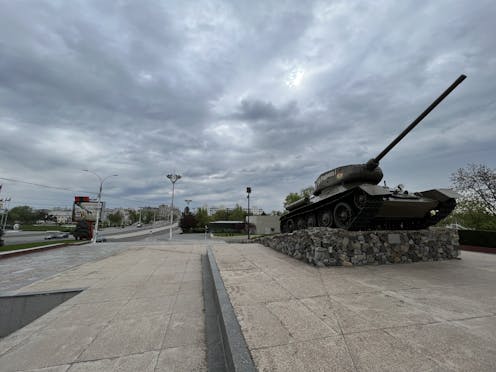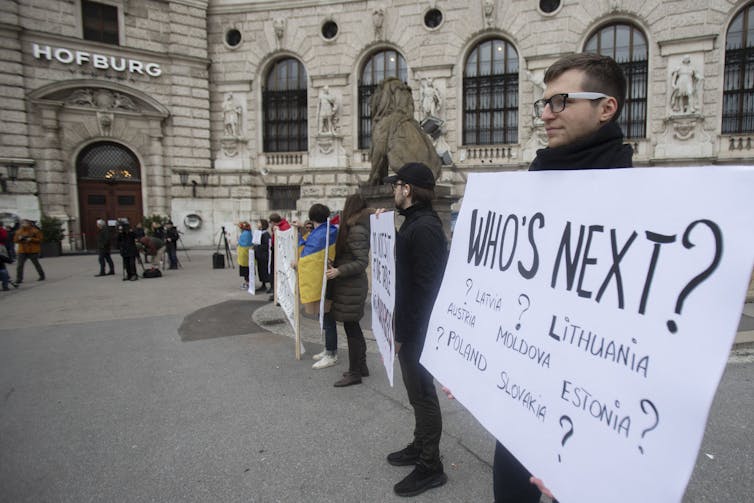
Tensions continue to mount between Russia and Moldova – a small country bordering on southwestern Ukraine that is seeking European Union membership. Moldova is also home to a breakaway region called Transnistria that has strong Russian ties, landing both places in the crosshairs of the war in Ukraine.
Moldova’s government voted on March 2, 2023, to formally condemn Russia’s illegal invasion of Ukraine.
This followed Moldovan politicians’ recently expressing concern that Russia is trying to overthrow its Western-leaning government and replace it with a puppet regime picked by the Kremlin.
Russian officials said in February 2023 that Ukraine is planning to invade Moldova – an accusation Moldovan officials struck down as a false-flag operation, meaning a military or political action carried out with the idea of falsely blaming an opponent.
In February 2023, following a meeting with Moldovan leaders in Poland, President Joe Biden reaffirmed strong U.S. support for Moldova’s sovereignty and territorial integrity.
As a scholar of Eastern European politics, I think that breaking down the complex dynamic among Moldova, Russia and Transnistria is useful in understanding Russia’s military interests beyond Ukraine. Here are five key points to keep in mind.
1. What is Transnistria?
Transnistria – officially called the Pridnestrovian Moldavian Republic by Moldova – is a narrow strip of land between Moldova and western Ukraine that is home to about 500,000 people. It is an unrecognized breakaway state that left Moldova after the collapse of the Soviet Union in 1990.
The Transnistrian government has de facto independence, but it is recognized by other countries and the United Nations as part of Moldova.
Although Russia also does not officially recognize Transnistria as an independent country, Transnistria retains its independence today thanks largely to the military support provided by the Russian army, stationed in Transnistrian territory.
Transnistria has close ties to Russia. People living there are largely Russian speakers and the government is run by pro-Russian separatists.
Russia also provides Transnistria with free natural gas and has supported older people in the region with pension supplements.
Approximately 1,500 Russian soldiers are stationed in Transnistria.
Only 50 to 100 of those soldiers are from Russia. The rest are local Transnistrians who have been given Russian passports. These soldiers have homes and families in Transnistria.
Moldova does not allow Russian soldiers to fly into the Chisinau International Airport. Since 2015, Ukraine refused them entry through its territory. These transportation restrictions led to Russia’s contracts with locals in Transnistria.
The Transnistrian military itself is relatively small and consists of 4,500 to 7,500 soldiers.
Russian military commander Rustam Minnekaev said on April 22, 2022, that Russia intended to establish a land corridor through southern Ukraine to Transnistria.
2. Why is Russia interested in Transnistria?
Russia has long sought to keep Moldova, formerly part of the Soviet Union, in its political sphere of influence. Moldova is located between the European Union and Ukraine, bordering Romania and southwestern Ukraine. Russian troops stationed in Transnistria give Moscow a way to intimidate Moldova and limit its Western aspirations.
Moldova applied for European Union membership in March 2022. Together with Ukraine, it received candidate status in June 2022.
The presence of Russian troops in Transnistria prevents Moldova from fully controlling its own borders. If activated, combat-ready Russian troops in Transnistria could quickly destabilize the region. Without border and territorial control, Moldova cannot join the EU. This is one of the conditions for EU membership.

3. Is Transnistria loyal to Russia?
While free gas has helped ensure Transnistria’s allegiance to Moscow, the European Union has also provided an economic lifeline to Transnistria with new trade deals.
Russia’s annexation of Crimea, a Ukrainian peninsula, in 2014, as well as Russia’s 2014 war with Ukraine over the Donbas region, transformed Transnistria’s economic orientation from Russia to Western Europe.
The fighting in Ukraine prompted Ukraine to reevaluate and tighten its border policy. This resulted in a crackdown on routes in and out of Transnistria that had been used for illegal trafficking of goods for nearly three decades.
The squeezing of contraband routes came at an opportune moment for Transnistria.
Moldova signed a free-trade deal with the European Union in 2014, also allowing trade to be conducted from Transnistria. Transnistria’s trade with Western Europe has since continued to grow, as its trade with Russia declines.
Today, more than 70% of Transnistria’s exports go to Western Europe.
4. How vulnerable is Moldova?
The Ukraine war and the presence of Russian troops in Transnistria have worried Moldovans and some international experts that Moldova could be Putin’s next invasion target.
Unlike Ukraine, Moldova has a weak military, comparable to Transnistria’s forces. Moldova’s active military personnel amounts to 6,000 soldiers, who likely do not have the ability to successfully fend off Russian troops.
Moldova is one of the poorest countries in Europe, with a population of about 2.6 million.
Moldova’s energy sector is one of its greatest vulnerabilities. In December 2022, for the first time, Moldova started importing natural gas from international markets, mainly from Romania. Before 2022, Moldova was 100% dependent on Russian gas, which made it difficult for Moldova to escape Moscow’s orbit, despite its pro-European political orientation.
On paper, Transnistria looks like an ideal place for Russia to easily launch attacks on Ukraine or Moldova. However, Transnistria on its own does not have much capability to fight against Ukraine, or the will to fight against Moldova.
Reaching Transnistria, in turn, would require Russia to make massive gains in southern areas of Ukraine, where Ukrainian troops liberated the city of Kherson in November 2022 in one of Ukraine’s most significant gains of the war. The city was a key link in Russia’s effort to control the southern coastline along the Black Sea.

5. Why are Russia-Moldova tensions again escalating?
Russia’s attention to Moldova and Transnistria could provide a distraction, as Ukraine focuses on the most intense fighting in the eastern part of the country ahead of a planned counteroffensive against Russia this spring.
Russia has repeatedly accused Ukraine of storing radioactive material and preparing to build a dirty bomb in pro-Russian Transnistria. In November 2022, the United Nations nuclear watchdog agency found no evidence of this work underway.
This kind of false allegation is similar to what the Kremlin said in 2022, when it justified the Ukraine invasion by saying without evidence that Russians were being targeted in the Donbas – the eastern part of Ukraine – and needed protection. In both cases, Russia asserted falsehoods about Ukraine to justify a potential military attack.
Both Ukraine and Moldova have denied that they are planning any military operation in Transnistria.
This is an updated version of an article originally published on April 27, 2022.
Tatsiana Kulakevich does not work for, consult, own shares in or receive funding from any company or organization that would benefit from this article, and has disclosed no relevant affiliations beyond their academic appointment.
This article was originally published on The Conversation. Read the original article.







